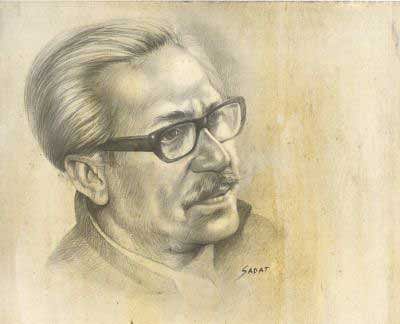Recalling Six Points

June 7 remains a milestone in the history of Bangladesh.
On this day in 1966, the people of what was then East Pakistan observed a general strike in the province in support of the Awami League's Six-Point programme of autonomy announced a few months earlier by Sheikh Mujibur Rahman.
The strike, in the course of which a number of individuals were killed in police firing and a number of others were injured, was a powerful instance of the Bangalees making their displeasure about their place in Pakistan known to the authorities.
But even as the general strike, or hartal, kept the province in its grip throughout the day, the central leaders of the Awami League -- Sheikh Mujibur Rahman, Tajuddin Ahmed, Syed Nazrul Islam and others -- stayed behind bars. The strike would be spearheaded by two young Awami League politicians, Mizanur Rahman Chowdhury and Amena Begum.
Mujib, who would not become Bangabandhu till three years later, had been placed in detention under the Defence of Pakistan Rules on 8 May 1966. The reason was not hard to understand: Field Marshal Mohammad Ayub Khan, president of Pakistan, had made clear his opinion on the Six Points. He told the country that the purveyors of the Six Points would be dealt with in the language of weapons.
Ayub Khan was not the only individual who spotted a threat to Pakistan's unity should the Six Points be acknowledged. His soon-to-be-out foreign minister Zulfikar Ali Bhutto challenged Mujib early in the year to a public debate at Dhaka's Paltan Maidan on the Six Points. It was Tajuddin Ahmed who accepted the challenge on Mujib's behalf. In the event, Bhutto did not turn up.
The Six-Point programme included the following:
1. Pakistan would have a federal structure of government based on spirit of the Lahore Resolution of 1940, with a parliament elected on the basis of universal adult franchise;
2. The central government would have authority only in defence and foreign affairs and all other subjects would be handled by the federating units of the state of Pakistan;
3. There would be two freely convertible currencies for the two wings of Pakistan or two separate reserve banks for the two regions of the country;
4. The power of taxation and revenue collection would be vested in the federating units;
5. There would be two separate accounts for foreign exchange reserves for the two wings of Pakistan;
6. East Pakistan would have a separate militia or paramilitary force as a measure of its security.
Sheikh Mujibur Rahman planned to announce the Six Points at a conference of opposition political parties in Lahore in early February 1966. He was not permitted to do so by the other participants, including the chief of the Awami League at the time, Nawabzada Nasrullah Khan. They found the plan too incendiary to be articulated. Rebuffed, Mujib announced the plan at a news conference in Lahore the following day, February 5, 1966.
Mujib's move raised howls of protest all over Pakistan. The civil-military bureaucracy and politicians straddling both government and opposition circles were quick to dub the Six Points as a secessionist plot to dismember Pakistan. Sheikh Mujibur Rahman's arrest in May 1966, followed by the 7 June strike, swiftly led to circumstances where the Pakistan government opted for repression in East Pakistan. Tofazzal Hossain Manik Mia, the respected editor of the Bangla daily Ittefaq, was arrested on June 16 over his support for the Six Points. The next day, a ban was clamped on his newspaper.
Events would move fast after June 1966. In January 1968, Mujib would be charged with conspiracy to break up Pakistan. The case, which would become notorious as the Agartala Conspiracy Case, would eventually be withdrawn under public pressure on February 22, 1969.
A day after his release, Mujib would be honoured as Bangabandhu (friend of Bengal) at a historic rally in Dhaka.

 For all latest news, follow The Daily Star's Google News channel.
For all latest news, follow The Daily Star's Google News channel. 



Comments